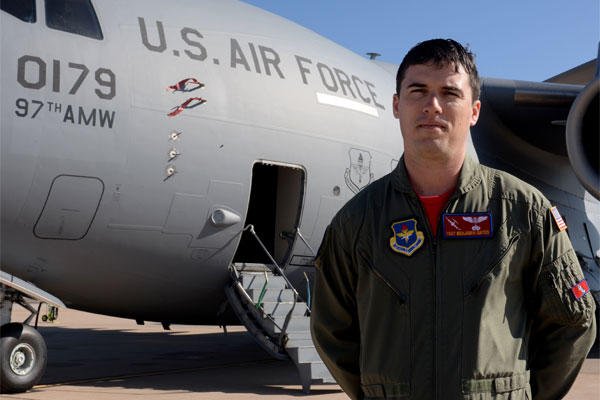ALTUS AIR FORCE BASE, Okla., Feb. 13, 2015 – Air Force Tech. Sgt. Benjamin Gates, 58th Airlift Squadron operations flight chief here, recently received the Vanguard Award for commandeering a boat to pull two people in distress out of the water roughly 300 meters from shore.
His actions ultimately saved one of the victim's lives.
The Vanguard Award recognizes enlisted members who have voluntarily performed a heroic act on or off duty to save a life or prevent serious injury.
"The [award] is prestigious, and I'm extremely honored," Gates said. "But more importantly, I am just thankful that we were able to make a difference for one of those victims that night."
It was July 16, 2014. At the time, Gates was stationed at Joint Base Charleston, South Carolina. He had taken leave to join a friend on a boat trip to North Carolina. His friend was a full-time captain of a 65-foot sport fishing yacht, and at about 10 p.m., they were docked at the Bohicket Marina, Johns Island, South Carolina, Gates said. They were planning to get up early and ferry the boat 14 hours up to North Carolina.
Screams in the Dark
As soon as he closed his eyes to sleep, Gates said, he heard screams for help.
"I had just barely fallen asleep and I heard somebody screaming for help, Gates said. “Initially I thought it was my buddy watching TV inside the boat. Next thing I know, he comes in and says, 'Ben, come outside right now!' We went out and heard somebody screaming somewhere in the water."
With little light, Gates had to rely on his ears to locate the source of the screams.
"All we heard was, 'Hey, come save us! Help! We can't swim, come get us!' So, we threw some life jackets towards the screams," he said. "But by that time one victim said, 'I can't swim back to the marina.' The current was basically pushing him up the creek because the tide was coming in, and at that point I just took over."
‘She Was Face Down in the Water’
Gates said there was a small, 14-foot boat on the other side of their dock that belonged to the marina. He jumped into it and noticed the boat’s keys were there.
“My friend and I started driving to the life jackets because they had lights flashing on them," Gates said. "When we got to the life jackets, there was a guy in the water and he was doing everything he possibly could to keep the second victim afloat. She was face-down in the water and unconscious, and he was close to drowning, too. He had swum with her for probably several hundred yards by the time we got there and was just out of breath."
They immediately lifted the victims out of the water and into the boat.
"We pulled the woman into the boat and she was unconscious,” he said. “She obviously had been in the water for a while. We got the second individual in the boat. I assessed the woman after she was on the boat and checked for her pulse, but she had no pulse and she was not breathing."
Gates said the woman’s face had “a very distinctive look” that he'll never forget for the rest of his life.
“It was the look of death,” he said. “Her skin was just snow- white.”
Training ‘Just Kicked In’
At that point, he recalled, they were about 300 yards from the marina. He said his self-aid buddy care training and U.S. Coast Guard Sea School training “just kicked in.” His friend started driving the boat while calling 911. Gates began CPR and continued for at least five minutes before they reached the dock, he said.
"By the time we got back to the dock there was a crowd that had gathered because they had heard the screams as well," he said. "There was an emergency medical technician there who relieved us of first aid and began doing CPR at that point."
Gates and his friend returned to the yacht they were traveling on and retrieved an automated external defibrillator. As they applied the AED to the victim, they heard sirens in the distance.
"I ran up the dock, found the first responders and directed them back down to where everybody was," Gates said. "From what I understand, they worked on the woman for about 45 minutes at the edge of the dock, got her breathing again. She had a pulse again and then they took her to the hospital."
The next morning, Gates and his friend got up early and left for North Carolina.
“When we got there we started getting phone calls from the sheriff's department,” he said. They were informed the woman had died two days later, as a result of being in the water for too long. Luckily, the other individual they rescued had survived.
"I was extremely grateful that we were able to get to them. We were the last possible bit of hope on that marina before they were gone, up the river," Gates said.
Just 'That Type of a Person'
Gates' supervisor at the time, Air Force Master Sgt. Harold P. Bordeaux, said he wasn’t surprised to learn about Gates’ actions that night.
"In my two years of working with him, ‘BG’ was a standout performer who would rather take a handshake or a pat on the back or a ‘job well done’ over any award," Bordeaux said. "I wouldn't expect any less from him. He's simply that type of a person.”
The experience reinforced Gates’ belief that training should always be taken seriously.
"It's one of those things where it can happen at any moment,” he said. “Be glad that you're trained for it and hopefully you'll never have to use it, but if you do, at least you'll be prepared.”




























